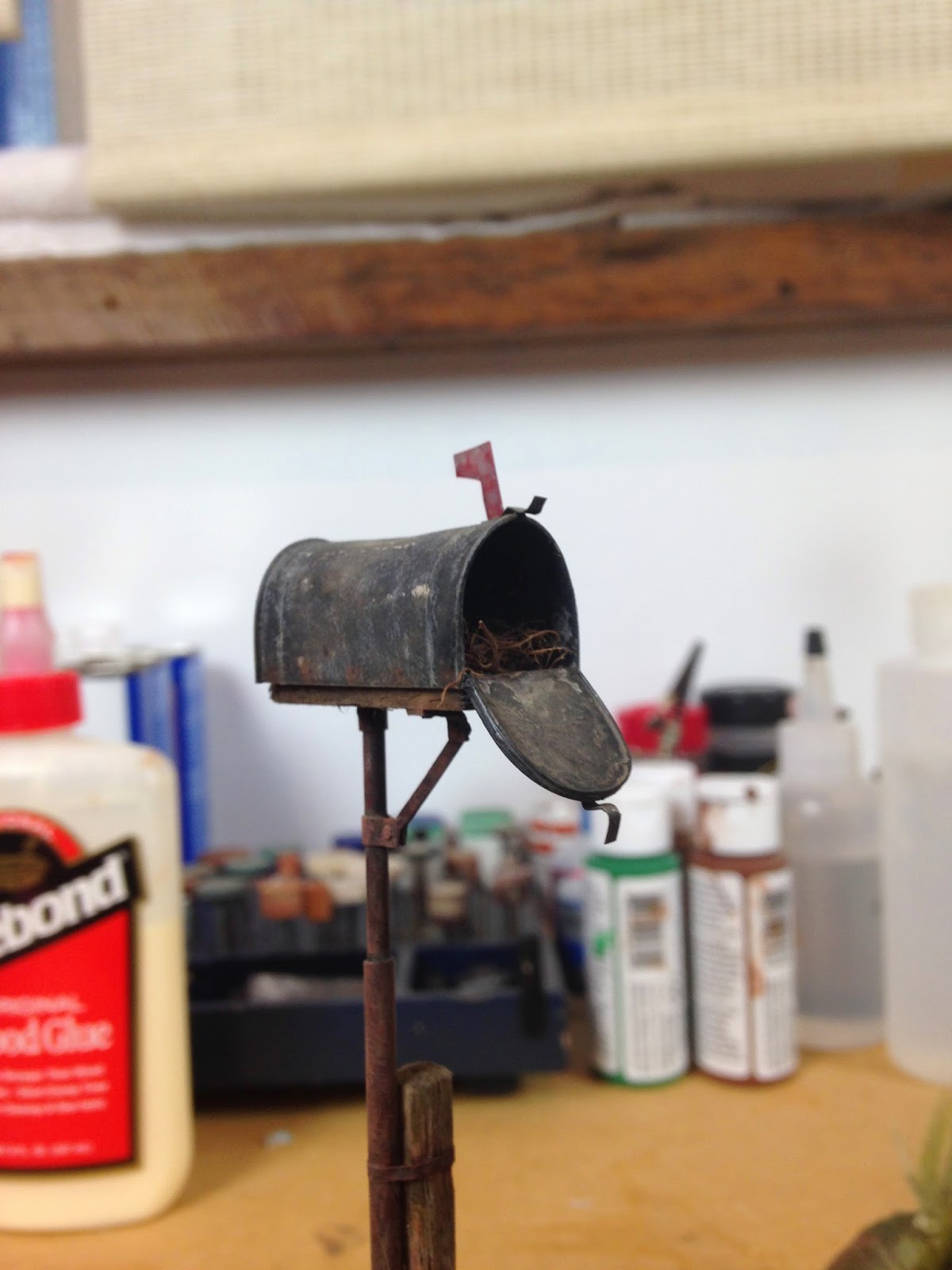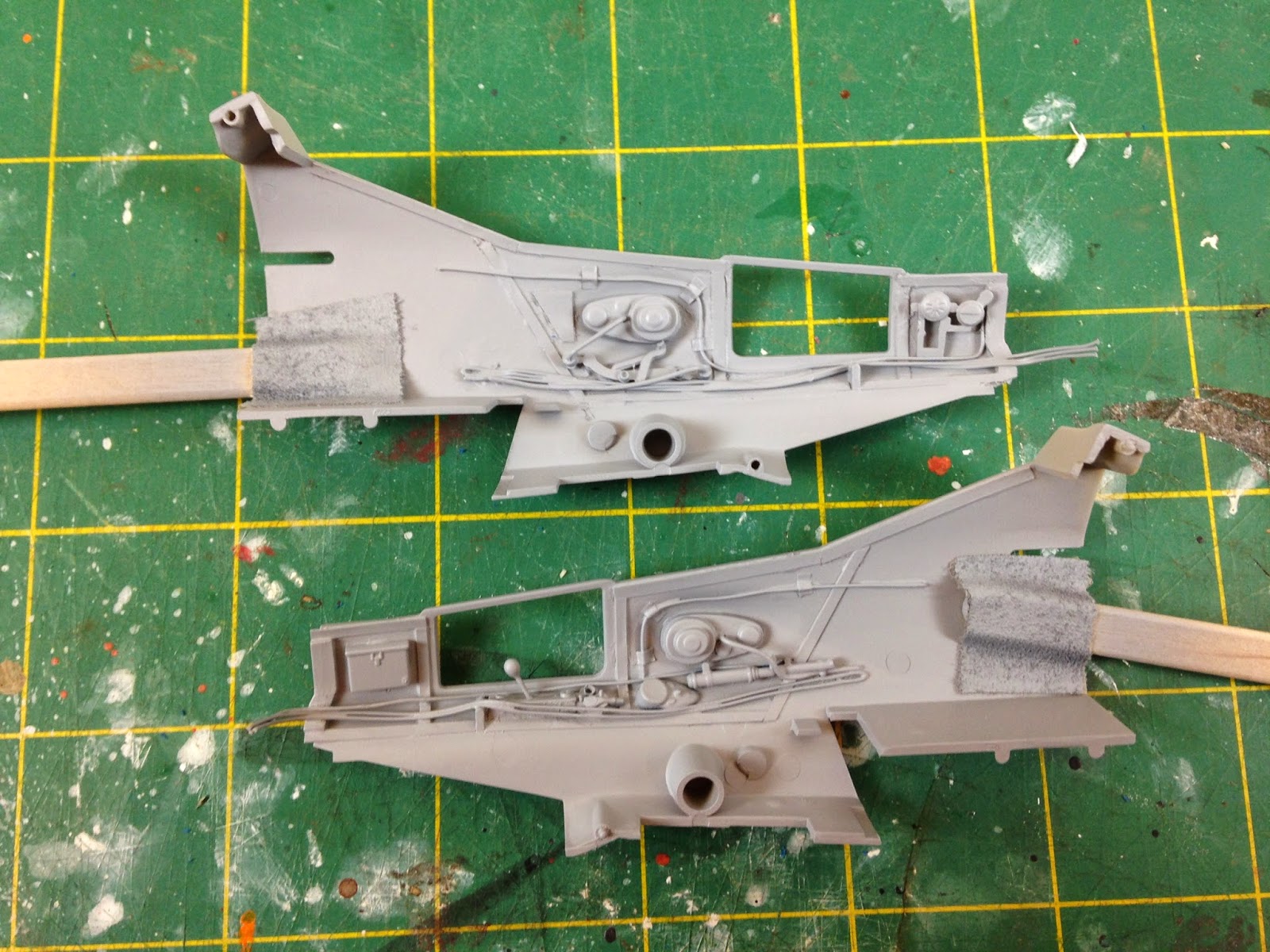Planning
I knew I wanted to build a diorama to bring the Krote to life. I wanted the diorama to tell some sort of story, and what eventually came to me was a simple story of the Krote stomping down a rural road, while a resistance fighter, wearing tattered clothes and armed with some sort of stolen weapon, lay in waiting underneath the road, hidden in an irrigation pipe, waiting until the enemy Krote strides past on its patrol, waiting to emerge from hiding and fire off his one shot to take the Krote down. Tom Joad with an RPG.
I sketched out the diorama on paper and bought a wooden base at Michaels.
Tom Joad with an RPG
I made the irrigation pipe from PVC tubing, cutting off the bottom 1/6 or so of the tube with a jigsaw so that it would lay flat on the base and cut down on the height of the finished diorama. I coated any areas that would be exposed with a mixture of Tamiya acrylic gray paint and baking soda to give it a grainy, cement-like texture.
For the resistance fighter, I modified the figure that came with the Krote kit. I used the typical technique of cutting the limbs apart at the joints, adding in wire and repositioning the figure to the pose that I wanted, filling gaps and resculpting clothes with Milliput. For Tom's weapon, I wanted him to have an old-school looking RPG - a subtle contrast to the more advanced weapon of the Krote. I wanted Tom to be all 80's "
Wolverines" in his weaponry.
So I looked up some reference material on the internet for
RPGs and built one up from brass tubing, Milliput, styrene, and bits from other model kits.
Once I had the figure and weapon together, I mounted him on a sheet of thick styrene that I had cut to slide into the PVC irrigation pipe. I then textured the surface of the styrene sheet with Celluclay, sand, pebbles, and dry crushed basil leaves. I painted the base and then slid it into the PVC pipe and glued it down.
Man-in-a-Tube
Once I had this sweet little man-in-a-tube put together, I installed it on the wooden base. I knew that I wanted the Krote to be walking down the road, which meant that it would need to have one foot lifted up into the air, which meant that the model would have to be well supported on only one foot. So, I installed a piece of brass tubing in the base before covering the irrigation pipe with foam and groundwork. I surrounded the tubing with Milliput to make it extra strong. A piece of brass rod extending from inside the Krote's leg and down through its foot would then slide right into the tubing, making for a nice sturdy tie-down.
Florists Foam
I built up the surrounding terrain with a fine-grain green florist's foam, which I may or may not use again.
LEARNING - This particular foam is really nice to shape and carve, but it leaves an incredible amount of plastic foam dust everywhere, which I can only imagine is not so great to breathe.
I pressed and then hot glued small rounded stones from the driveway into the foam where I wanted some larger exposed rocks once the groundwork was applied, and I built a retaining wall on one side of the ravine from balsa wood.
LEARNING - Next time I'll use basswood or another harder wood rather than balsa wood. Balsa is super easy to carve and cut, but to me it doesn't have a realistic scale grain.
Ground Texture
From there, ground texture was added with a mixture of Celluclay, wood glue, water, cheap brown acrylic paint, and sand and small pebbles. I like to go with a thin, wet layer of Celluclay so that I can really sculpt the groundwork - think the consistency of icing on a cake. Once I had it applied, I sprinkled on more sand and pebbles here and there.
Scale Tin Cans
I take my daughter down to the creek a lot, and we often pull garbage and detritus out of the water that has washed downstream or sat on the creek bottom for years. I wanted to add such a detail to the dry creek bed. I remembered an old article in Fine Scale Modeler describing how to make scale tin cans out of heavy tin foil, so I made one. I love these kinds of details.

The simple technique is to flatten out some heavy kitchen tin foil, cut it with a new X-acto blade to the right width for the scale tin can (adding in a bit of overlap to make a seam), then wrap the foil around a piece of brass tubing that is the right diameter for the scale. Once wrapped, carefully glue the seam with a bit of super glue. Let that cure, then run the X-acto around the brass tube where you want to cut the top and bottom of the tin can and slide off the tin can. Sharpen the inside edge of the piece of brass tubing with a file or Dremel and then use it to punch a lid and bottom for the can. Glue on the bottom, and then fray the edges of the top a bit to simulate the use of a can opener and then glue on the top. It took about 5 minutes to make this can - fun little project before work one morning.
I dented the can (use a light touch - it is tin foil) and painted it a rust color since it was too have been on the bottom of a creek bed for years and embedded it in the wet Celluclay along with some bits of wire and other debris.
Color and Grass
From there I applied different washes to the groundwork, and had a hell of a time getting it to look the way I wanted it to. Painting the groundwork just seemed to make it look ... painted. I used to be a big fan of drybrushing, but these days to me it often just doesn't look right. Pastels turned out to be the trick.
I applied a few layers of static grass as well as Woodland Scenics tall grasses, and then gave everything, especially the road, a good dusting with ground down earth-colored pastels. Love the effect, especially since you can carry the exact same dusting up onto the Krote to tie everything together really nicely and make it all part of the same dusty world. Once the pastel dust was applied, I ran my finger over the tops and points of rocks and smaller stones. The natural oil in my finger pulled just enough of the pastel off to show their tops.
LEARNING - I don't completely love the way that the Woodland Scenics tall grass came out. No fault of the product - it's my application. The way that I applied it, it has too much of the hair-plug look to it and it doesn't feel totally integrated with the surrounding grass. I think it's partially the colors of the tall grass - though I did apply a wash of greenish-brown to it to tone it down and connect it better to the short grass - but I still don't love it. Next time I want to experiment more with using a different tall grass color or an installation method that really ties it all together.
These two guys totally have it dialed in, with the look similar to what I'm going for. Love the work of these two guys.
Mailbox
To add to the rural feel, I wanted to build a mailbox. The idea was to use the mailbox to subtly hint that whatever was happening in the world, societal infrastructure was down. Tom and this Krote were part of a much bigger picture, where whoever this Krote represents has taken over, and the Tom Joads of the world were resorting to guerrilla warfare to stop them. So I built the mailbox with the front open, the flag up, and the inside now inhabited by a bird's nest. In other words, this mailbox has not been used for a while. Something is amiss.

I built the mailbox from sheet styrene and the super-thin tin from the lid of a single-serving honey container that I picked up while traveling. The tin was the perfect material for the rounded barrel of the mailbox. I simply cut it to the right dimensions and then wrapped it half-way around a big piece of brass tubing. The great thing about this tin is that it dented just like the real thing - I just tapped it with the end of a metal file to make nice dents.
The base of the mailbox was made with brass tubing, styrene, and balsa wood. I made the bird's nest from a tangle of fine hair-like roots from some shrub or plant. I seriously think I've had those roots for over 20 years.
Like the rusty tin can, the mailbox is another nice detail to bring some life and a bit of story to the diorama.








































